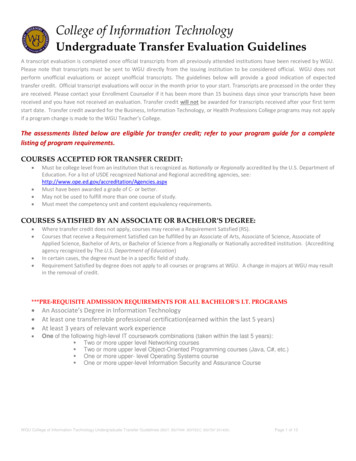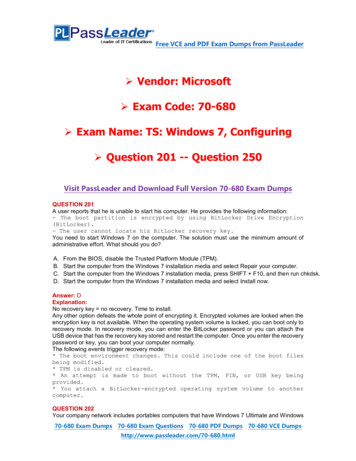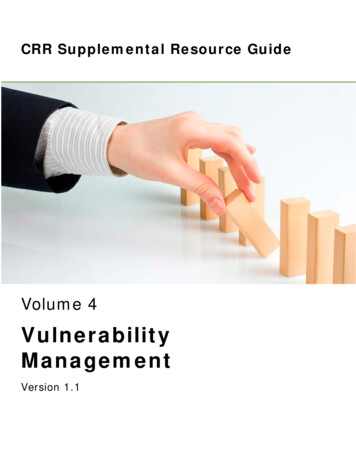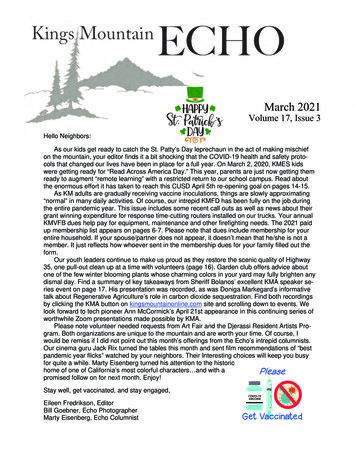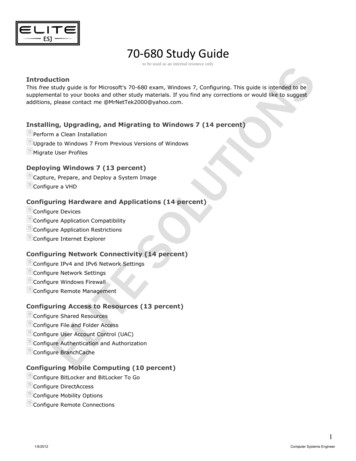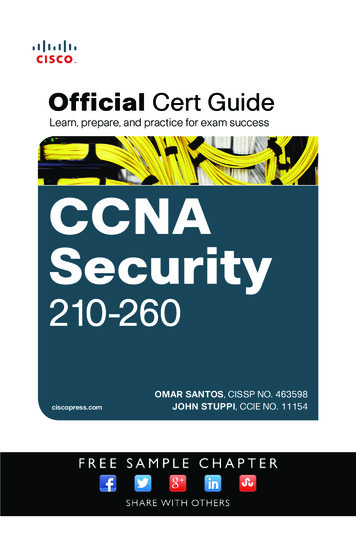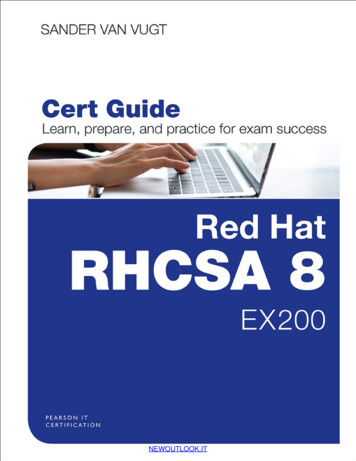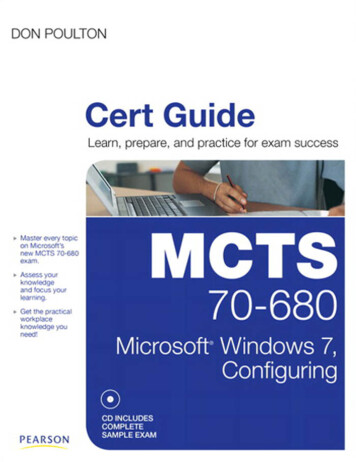
Transcription
MCTS 70-680 Cert Guide:Microsoft Windows 7,ConfiguringDon PoultonPearson800 East 96th StreetIndianapolis, Indiana 46240 USA
iiMCTS 70-680 Cert Guide: Microsoft Windows 7, ConfiguringMCTS 70-680 Cert Guide:Microsoft Windows 7, ConfiguringCopyright 2011 by Pearson Education, Inc.All rights reserved. No part of this book shall be reproduced, stored in aretrieval system, or transmitted by any means, electronic, mechanical,photocopying, recording, or otherwise, without written permission fromthe publisher. No patent liability is assumed with respect to the use of theinformation contained herein. Although every precaution has been takenin the preparation of this book, the publisher and author assume noresponsibility for errors or omissions. Nor is any liability assumed fordamages resulting from the use of the information contained herein.ISBN-13: 978-0-7897-4707-5ISBN-10: 0-7897-4707-3Library of Congress Cataloging-in-Publication Data is on file.Printed in the United States of AmericaFirst Printing: November 2010TrademarksAll terms mentioned in this book that are known to be trademarks or service marks have been appropriately capitalized. Pearson IT Certificationcannot attest to the accuracy of this information. Use of a term in this bookshould not be regarded as affecting the validity of any trademark or servicemark.Warning and DisclaimerEvery effort has been made to make this book as complete and as accurateas possible, but no warranty or fitness is implied. The information provided is on an “as is” basis. The authors and the publisher shall have neitherliability nor responsibility to any person or entity with respect to any lossor damages arising from the information contained in this book or fromthe use of the CD or programs accompanying it.Bulk SalesPearson IT Certification offers excellent discounts on this book when orderedin quantity for bulk purchases or special sales. For more information,please contactU.S. Corporate and Government or sales outside of the U.S., please contactInternational Salesinternational@pearson.comAssociate PublisherDave DusthimerAcquisitions EditorBetsy BrownDevelopment EditorBox TwelveCommunications, Inc.Managing EditorSandra SchroederProject EditorMandie FrankCopy EditorMike HenryIndexerTim WrightProofreaderMegan WadeTechnical EditorChris CraytonPublishing CoordinatorVanessa EvansMultimedia DeveloperDan ScherfInterior DesignerLouisa AdairCover DesignerGary AdairCompositionMark Shirar
Contents at a GlanceIntroduction 3Chapter 1Introducing Windows 7 17Chapter 2Installing Windows 7 47Chapter 3Upgrading to Windows 7 87Chapter 4Migrating Users and Applications to Windows 7 107Chapter 5Deploying Windows 7 127Chapter 6Configuring Virtual Hard Disks 187Chapter 7Configuring Devices and Updates 211Chapter 8Configuring Applications and Internet Explorer 243Chapter 9Configuring TCP/IP 297Chapter 10Configuring Network and Firewall Settings 339Chapter 11Configuring Access to Local and Shared Resources 383Chapter 12Configuring Access Controls 433Chapter 13Configuring Mobile Computing 475Chapter 14Configuring Remote Management and Remote Connections 521Chapter 15Disk Management 561Chapter 16Managing and Monitoring System Performance 591Chapter 17Configuring Backups 643Chapter 18Configuring System and File Recovery 661Practice Exam 689Answers to Practice Exam 747Appendix AAnswers to the “Do I Know This Already?” Quizzes 785Appendix BGlossary 817Index836Elements Available on CDAppendix CMemory TablesAppendix DMemory Tables Answer Key
ivMCTS 70-680 Cert Guide: Microsoft Windows 7, ConfiguringTable of ContentsIntroduction 3Chapter 1Introducing Windows 7 17Leading Up to Windows 7 17Windows 7 Editions 20Features of Windows 7 23Productivity Improvements 23Security Improvements 27A Quick Tour of Windows 7 29Start Menu and Taskbar 30Configuring Windows 7 Start Menu and Taskbar 32Start Menu Properties 32Taskbar Properties 33Toolbars 34Libraries 34Control Panel 35System and Security 36Network and Internet 38Hardware and Sound 39Programs 40User Accounts and Family Safety 41Appearance and Personalization 42Clock, Language, and Region 43Ease of Access 43Patches, Hotfixes, and Service Packs 43Summary 44Chapter 2Installing Windows 7 47“Do I Know This Already?” Quiz 47Identifying Hardware Requirements 51Hardware Compatibility 52Software Compatibility 53Network Requirements 55File System Considerations 56Product Activation 57Performing a Clean Installation of Windows 7 as the Sole Operating System 59Performing an Attended Installation 59
Contents vDual-Booting Windows 7 65Boot Management Programs Used by Windows 7 65Setting Up a Dual-Boot System 66Other Windows 7 Installation Methods 66USB 67CD 67Network Share 67WDS 68Understanding WDS 68Requirements to Use WDS 69Troubleshooting Windows 7 Installation Issues 70Troubleshooting Process 70Identifying the Point of Failure 71Discovering the Cause of the Failure 71Defining a Solution 72Testing and Implementing the Solution 72Documenting the Results 72Troubleshooting an Attended Installation 72Media Problems 73Insufficient Hard Drive Space 73Unrecognizable DVD-ROM Drive 74Unavailable Network 74Advanced Startup 80Refer to Compatibility 80Troubleshooting Failed Installations 82Stop Errors or Blue Screen of Death 83Stopped Installation 84Review All the Key Topics 85Complete the Tables and Lists from Memory 85Definitions of Key Terms 85Chapter 3Upgrading to Windows 7 87“Do I Know This Already?” Quiz 87Upgrading to Windows 7 from a Previous Versionof Windows 91Preparing a Computer to Meet Upgrade Requirements 92Windows 7 Upgrade Advisor 92
viMCTS 70-680 Cert Guide: Microsoft Windows 7, ConfiguringAdditional Preparatory Tasks 94Upgrading the Computer to Windows 7 95Migrating from Windows XP 97The Windows.old Folder 98Removing the Windows.old Folder 99Upgrading from One Edition of Windows 7 to Another 100Windows Anytime Upgrade 101Upgrading Windows 7 101Uninstalling Windows 7 102Review All the Key Topics 104Complete the Tables and Lists from Memory 104Definitions of Key Terms 104Chapter 4Migrating Users and Applications to Windows 7 107“Do I Know This Already?” Quiz 107Migrating Users from One Computer to Another 111User State Migration Tool 111Preparing the Server to Run USMT 113Collecting Files from the Source Computer 114Loading Collected Files on the Destination Computer 115Windows Easy Transfer 115Using Windows Easy Transfer to Collect Files at the Source Computer 116Using Windows Easy Transfer to Save Files atthe Destination Computer 118Migrating Users from Previous Windows Versions 120Using the User State Migration Tool 121Using Windows Easy Transfer 122Side by Side Versus Wipe and Load 122Side by Side Migration 123Wipe and Load Migration 123Review All the Key Topics 125Definitions of Key Terms 125Chapter 5Deploying Windows 7 127“Do I Know This Already?” Quiz 127Planning a Windows 7 Deployment 132Understanding Windows Images 133Understanding Windows PE 134
Contents viiUnderstanding Answer Files 137Understanding Configuration Passes 138Creating an Answer File 139Using the Answer Files to Perform an Unattended Installation 144Capturing a System Image 145Understanding the System Preparation Tool 145Using Sysprep to Prepare a System for Capture 146Creating a WIM File 148Automated Image Capture 148Manual Image Capture 150Preparing System Images for Deployment 151Understanding the Deployment Image Servicing andManagement Utility 151Working with DISM 153Inserting Applications into System Images 154Inserting Drivers into System Images 156Inserting Updates into System Images 157Configuring Tasks to Run After Deployment 157Deploying Windows System Images 158Suggested Deployment Strategies 158High-Touch with Retail Media 159High-Touch with Standard Image 159Lite-Touch, High-Volume Deployment 160Zero-Touch, High-Volume Deployment 160Using Microsoft Deployment Toolkit 2010to Deploy Windows 7 161What’s New with MDT 2010 161Downloading and Installing MDT 2010 162Using MDT 2010 Deployment Workbench to Create a Deployment Share 163Adding Windows Images to the Deployment Share 165Adding Additional Features to Windows Images 168Using Task Sequences in MDT 2010 169Using Deployment Points 173Using MDT 2010 to Distribute Images to Multiple Computers 173Automated Deployment of Windows 7 by Using WindowsDeployment Services 174Understanding WDS 174
viiiMCTS 70-680 Cert Guide: Microsoft Windows 7, ConfiguringSetting Up WDS 175Using WDS to Perform an Automated Deployment of Windows 7 177Enabling Automatic Network Boot 177Automating the Setup Process 178Manually Deploying a Customized Image 179Troubleshooting an Unattended Installation 180Problems with Answer Files 180Boot Disks 180Switches 181Answer File Specifications 181Problems with Sysprep Installations 182Review All the Key Topics 184Complete the Tables and Lists from Memory 184Definitions of Key Terms 185Chapter 6Configuring Virtual Hard Disks 187“Do I Know This Already?” Quiz 187Understanding VHDs 191What’s New in Virtual Hard Disks? 191Types of Virtual Hard Disks 192Tools Used with Virtual Hard Disks 193Creating and Configuring VHDs 194Creating VHDs 194Using Disk Management 194Using DiskPart to Create a VHD 196Mounting VHDs 198Deploying VHDs 199Preparing a Custom Windows Image 200Best Practices for Using Native-Boot VHDs 200Creating a Native-Boot VHD 201Booting VHDs 203Adding a Native-Boot VHD to an Older Computer 204Offline Servicing and Updating VHDs 205Upgrading a Windows Image to a Higher Edition 208Using an Answer File to Service an Offline VHD 208Review All the Key Topics 209Complete the Tables and Lists from Memory 209Definitions of Key Terms 209
Contents ixChapter 7Configuring Devices and Updates 211“Do I Know This Already?” Quiz 211Installing and Configuring Device Drivers 215Installing Devices and Drivers 216Device Stage 217Updating Drivers 218Using Device Manager 219Using Device Manager to Uninstall Drivers 222Using Device Manager to Disable Drivers 223Maintaining Device Drivers 223Managing and Troubleshooting Drivers and Driver Signing 224What’s New with Driver Signing in Windows 7 224Checking Drivers for Digital Signatures 225Driver Installation Permissions in Windows 7 227Configuring Driver Settings 227Troubleshooting Device Drivers 228Resolving Driver Conflicts 228Use of the Action Center to View Device-Related Problems 230Use of System Information to View Device-Related Problems 231Using Windows 7 Rollback to Resolve a Problem Driver 231Configuring Updates to Windows 7 232Configuring Windows Update Settings 233Using a WSUS Server with Windows 7 235Configuring Windows Update Policies 236Reviewing Update History and Rolling Back Updates 239Checking for New Updates 240Review All the Key Topics 241Complete the Tables and Lists from Memory 241Definitions of Key Terms 241Chapter 8Configuring Applications and Internet Explorer 243“Do I Know This Already?” Quiz 243Configuring Application Compatibility 248Configuring Application Compatibility Mode 248Implementing Shims 250Using the Application Compatibility Toolkit 251Windows XP Mode 253Internet Explorer Compatibility Issues 255
xMCTS 70-680 Cert Guide: Microsoft Windows 7, ConfiguringConfiguring Application Restrictions 257Setting Software Restriction Policies 258Application Control Policies 262Capabilities of AppLocker 262Basic Configuration of AppLocker Policies 263Creating Additional AppLocker Rules 265Configuring Internet Explorer 270Configuring Compatibility View 271Configuring Security Settings 273Configuring Internet Explorer Security Zones 274Configuring Protected Mode in Internet Explorer 276Configuring the SmartScreen Filter 277Privacy Tab Settings 279Handling Cookies 279Blocking Pop-ups 281Content Tab Settings 282Advanced Tab Settings 283Configuring Providers 283Managing Add-ons 285Using Accelerators 287Using InPrivate Browsing Mode 288InPrivate Browsing Group Policies 290Certificates for Secure Websites 291Review All the Key Topics 294Complete the Tables and Lists from Memory 295Definitions of Key Terms 295Chapter 9Configuring TCP/IP 297“Do I Know This Already?” Quiz 297Understanding the TCP/IP Protocol 301Configuring TCP/IP Version 4 303Static IPv4 Addressing 304Classless Inter-Domain Routing 306Private IPv4 Networks 307Dynamic IP Addressing 307Connecting to a Network 308Using the Network and Sharing Center to Set Up aTCP/IP v4 Connection 309
Contents xiConfiguring IPv4 Name Resolution 313Implementing APIPA 315Configuring TCP/IP Version 6 316IPv6 Address Syntax 316IPv6 Prefixes 316Types of IPv6 Addresses 317Compatibility Between IPv4 and IPv6 Addresses 318Connecting to a TCP/IP Version 6 Network 319Configuring TCP/IPv6 Name Resolution 322Disabling IPv6 323Link-Local Multicast Name Resolution 323Resolving IPv4 and IPv6 Network Connectivity Issues 324Windows 7 Network Diagnostics Tools 324Using TCP/IP Utilities to TroubleshootTCP/IP 325ARP 326FTP and TFTP 29tracertpathping330330Troubleshooting IPv4 and IPv6 Problems 330A Suggested Response to a Connectivity Problem 331Network Discovery 332Incorrect IPv4 Address or Subnet Mask 332Unable to Connect to a DHCP Server 333Duplicate IP Address 333Unable to Configure an Alternate TCP/IPv4Configuration 333Using Event Viewer to Check Network Problems 334Additional Troubleshooting Hints When Using IPv6 334Review All the Key Topics 335Complete the Tables and Lists from Memory 335Definitions of Key Terms 336
xiiMCTS 70-680 Cert Guide: Microsoft Windows 7, ConfiguringChapter 10Configuring Network and Firewall Settings 339“Do I Know This Already?” Quiz 339Configuring Networking Settings 344Network Devices and Locations 344Setting Up New Network Connections 346Connecting to Existing Networks 347Setting Up Network Sharing and Discovery 348Using Internet Connection Sharing to Share YourInternet Connection 349Connecting to Wireless Networks 352Wireless Networking Protocols 354Setting Up a Wireless Network Connection 354Managing Wireless Network Connections 357Wireless Network Profiles 359Configuring Location Aware Printing 360Configuring Security Settings in Windows Firewall 361Basic Windows Firewall Configuration 362Using the Windows Firewall with Advanced Security Snap-in 368Configuring Multiple Firewall Profiles 369Configuring New Firewall Rules 371Modifying Rule Properties 375Configuring Notifications 376Group Policy and Windows Firewall 376Review All the Key Topics 379Complete the Tables and Lists from Memory 379Definitions of Key Terms 380Chapter 11Configuring Access to Local and Shared Resources 383“Do I Know This Already?” Quiz 383Configuring Shared Resources 389Using the Network and Sharing Center to Configure File Sharing 389Sharing Files, Folders, and Printers 390Modifying Shared Folder Properties 392Use of the Public Folder for Sharing Files 396Mapping a Drive 396Command-Line Administration of Shared Folders 397Password-Protected Sharing 398
Contents xiiiMedia Streaming 398Folder Virtualization 399Sharing Printers 401Configuring Homegroup Settings 403Creating a HomeGroup 403Joining a Homegroup 403Modifying Homegroup Settings 405Configuring Security Permissions 406NTFS File and Folder Permissions 407Applying NTFS Permissions 408Specifying Advanced Permissions 410NTFS Permissions Inheritance 414Taking Ownership of Files and Folders 415Effective Permissions 416Viewing a User’s Effective Permissions 417Copying and Moving Files and Folders 418Copying Files and Folders with NTFS Permissions 418Moving Files and Folders with NTFS Permissions 419Using the Mouse to Copy or Move Objects from One Location to Another 420Practical Guidelines on Sharing and Securing Folders 420Configuring Data Encryption 421Encrypting File System Basics 422Preparing a Disk for EFS 424Encrypting Files 425Backing Up EFS Keys 426Decrypting Files 427EFS Recovery Agents 427Review All the Key Topics 430Complete the Tables and Lists from Memory 431Definitions of Key Terms 431Chapter 12Configuring Access Controls 433“Do I Know This Already?” Quiz 433Configuring User Account Control 438Features of User Account Control 439Application Prompts 442Running Programs with Elevated Privileges 443
xiv MCTS 70-680 Cert Guide: Microsoft Windows 7, ConfiguringConfiguring User Account Control 444User Account Control Policies 446Configuring Authentication and Authorization 449Controlling Windows Logon 450Managing Credentials 450Adding, Editing, and Removing Credentials in Credential Manager 451Backing Up and Restoring Credentials in Credential Manager 453Managing Certificates 454Using Smart Cards 456Smart Cards and Multifactor Authentication 457Smart Card Policies 457Configuring Account Policies 458Password Policies 458Account Lockout 460Unlocking an Account 460Configuring User Rights 461Resolving Authentication Issues 464Resetting Passwords 464Using a Password Reset Disk 465Configuring BranchCache 466Distributed Cache and Hosted Cache 467Configuring BranchCache Settings 467Using the netsh Command to Configure BranchCache 467Using Group Policy to Enable BranchCache 468Specifying BranchCache Firewall Rules 470BranchCache Network Infrastructure Requirements 471Using BranchCache Across a Virtual Private Network 471Certificate Management with BranchCache 472Review All the Key Topics 473Definitions of Key Terms 473Chapter 13Configuring Mobile Computing 475“Do I Know This Already?” Quiz 475Configuring BitLocker and BitLocker To Go 479BitLocker Drive Encryption 479Preparing Your Computer to Use BitLocker 480Enabling BitLocker 481
Contents xvManaging BitLocker 484BitLocker To Go 485BitLocker Policies 486Operating System Drives 487Fixed Data Drive Policies 488Use of Data Recovery Agents 489Configuring DirectAccess 491Network Infrastructure Requirements 493Using IPv6 with DirectAccess 493Use of Network Access Protection 494The DirectAccess Connection Process 494Configuring DirectAccess Clients 495Configuring Authentication 496Configuring Mobility Options 497Control Panel 497Windows Mobility Center 498Using Offline Files 499Client Computer Configuration 500Server Configuration 502Use of the Sync Center 503Offline File Policies 506Configuring Transparent Caching of Offline Files 508Configuring Power Options 508Power Plans 510Additional Power Plan Options 511Advanced Power Settings 512Battery Meter 515Power Management and Group Policy 515Review All the Key Topics 518Complete the Tables and Lists from Memory 519Definitions of Key Terms 519Chapter 14Configuring Remote Management and Remote Connections 521“Do I Know This Already?” Quiz 521Configuring Remote Management 525Remote Desktop 525Establishing a Remote Desktop Connection with Another Computer 525
xviMCTS 70-680 Cert Guide: Microsoft Windows 7, ConfiguringConfiguring the Server Side of Remote Desktop 527Selecting a Nondefault Port 529Remote Assistance 530Using Windows Remote Management Service 535Using Windows Remote Shell 536Using Windows PowerShell 537Configuring Remote Connections 540Understanding Remote Access 541Remote Access Authentication Protocols 541Remote Access Security 543Establishing VPN Connections and Authentication 544VPN Connection Security 547Enabling VPN Reconnect 548Advanced Security Auditing 549NAP Quarantine Remediation 550Configuring Dial-Up Connections 552Accepting Incoming Connections 554Published Applications on Remote Desktop 555RD Gateway Policies 557Using RemoteApp to Specify Applications 558Review All the Key Topics 558Complete the Tables and Lists from Memory 559Definitions of Key Terms 559Chapter 15Disk Management 561“Do I Know This Already?” Quiz 561Managing Disks and Volumes 565Basic and Dynamic Disks 566Working with Basic Disks 568Converting Basic Disks to Dynamic 572Working with Dynamic Disks 574Troubleshooting Disk Problems 576Managing File System Fragmentation 578Disk Defragmenter 578The Defrag.exe Command-Line Tool 580Error Checking 581RAID Volumes 582
Contents xviiCreating a RAID-0 Volume 582Creating a Spanned Volume 585Creating a Mirrored Volume 585Creating a RAID-5 Volume 585Using DiskPart to Create Striped, Mirrored, and RAID-5Volumes 586Managing and Troubleshooting RAID Volumes 587Configuring Removable Drive Policies 587Review All the Key Topics 589Complete the Tables and Lists from Memory 589Definitions of Key Terms 589Chapter 16Managing and Monitoring System Performance 591“Do I Know This Already?” Quiz 591Windows System Monitoring Tools 596Configuring and Working with Event Logs 600Viewing Logs in Event Viewer 601Customizing Event Viewer 602Creating Tasks from Events 603Using Event Log Subscriptions 604Configuring Computers to Forward and Collect Events 604Configuring Event Log Subscriptions 605Managing Computer Performance 608Reliability Monitor 608Task Manager 610Configuring Application Priority 612Resource Monitor 613CPU Tab 614Memory Tab 614Disk Tab 615Network Tab 615Performance Monitor 615Data Collector Sets 619Creating Data Collector Sets 619Using Performance Monitor to Create a Data Collector Set 622Optimizing and Troubleshooting Memory Performance 623Optimizing and Troubleshooting Processor Utilization 625
xviiiMCTS 70-680 Cert Guide: Microsoft Windows 7, ConfiguringOptimizing and Troubleshooting Disk Performance 626Command-Line Utilities 628Configuring Additional Performance Settings 628Configuring the Hard Drive Cache 628Windows ReadyBoost 629System Configuration Utility 631General Tab 631Boot Tab 632Services Tab 632Startup Tab 633Tools Tab 633Configuring the Relative Priority of Foreground and Background Tasks 633Configuring Processor Scheduling 634Action Center 635Advanced Networking Performance Options 636Configuring Services and Programs to Resolve Performance Issues 636Review All the Key Topics 639Complete the Tables and Lists from Memory 639Definitions of Key Terms 640Chapter 17Configuring Backups 643“Do I Know This Already?” Quiz 643Using Windows Backup to Protect Your Data 646Configuring Windows Backup for the First Time 646Managing and Troubleshooting Your Backups 650Scheduling Your Backups 653Using the Command Line to Perform a Backup 654Creating a System Image 655Creating a System Recovery Disk 657Review All the Key Topics 658Complete the Tables and Lists from Memory 658Definitions of Key Terms 658Chapter 18Configuring System and File Recovery 661“Do I Know This Already?” Quiz 661Restoring Files and Folders 665Using Windows Backup to Recover Data 665Restoring User Profiles 669
Contents xixUsing Shadow Copies to Restore Damaged or Deleted Files 669System Restore 671Running System Restore 672Configuring System Restore Properties 674Device Driver Rollback 675Recovering Your Operating System from Backup 676Using a System Repair Disk 679Advanced System Startup Options 682Last Known Good Configuration 682Safe Mode 684Boot Logging 685Low Resolution Video (640 480) 685Debugging Mode 685Disable Automatic Restart on System Failure 685Disable Driver Signature Enforcement 685Review All the Key Topics 686Complete the Tables and Lists from Memory 686Definitions of Key Terms 686Practice Exam 689Answers to Practice Exam 747Appendix AAnswers to the “Do I Know This Already?” Quizzes 785Appendix BGlossary 817Index 836Elements Available on CDAppendix CMemory TablesAppendix DMemory Tables Answer Key
xxMCTS 70-680 Cert Guide: Microsoft Windows 7, ConfiguringAbout the AuthorDon Poulton (A , Network , Security , MCSA, MCSE) is an independent consultant who has been involved with computers since the days of 80-column punchcards. After a career of more than 20 years in environmental science, Don switchedcareers and trained as a Windows NT 4.0 MCSE. He has been involved in consulting with a couple of small training providers as a technical writer, during whichtime he wrote training and exam prep materials for Windows NT 4.0, Windows2000, and Windows XP. Don has written or contributed to several titles, includingSecurity Lab Manual (Que, 2004); MCSA/MCSE 70-299 Exam Cram 2:Implementing and Administering Security in a Windows 2003 Network (Exam Cram 2)(Que, 2004); MCSE 70-294 Exam Prep: Planning, Implementing, and Maintaining aMicrosoft Windows Server 2003 Active Directory Infrastructure (Que, 2006); andMCTS 70-620 Exam Prep: Microsoft Windows Vista, Configuring (Que, 2008).In addition, he has worked on programming projects, both in his days as an environmental scientist and more recently with Visual Basic to update an older statistical package used for multivariate analysis of sediment contaminants.When not working on computers, Don is an avid amateur photographer who hashad his photos displayed in international competitions and published in magazinessuch as Michigan Natural Resources Magazine and National Geographic Traveler. Donalso enjoys traveling and keeping fit.Don lives in Burlington, Ontario, with his wife, Terry.
xxiDedicationI would like to dedicate this book to my wife Terry, who has stood by my side and encouragedme throughout the days spent writing this book. This project would not have been possiblewithout her love and support.
xxii MCTS 70-680 Cert Guide: Microsoft Windows 7, ConfiguringAcknowledgmentsI would like to thank all the staff at Pearson IT Certification and in particular BetsyBrown for making this project possible. My sincere thanks goes out to ChrisCrayton for his helpful technical suggestions, as well as Jeff Riley, developmenteditor, and Chris Cleveland, development editor liason, for their improvements tothe manuscript.—Don Poulton
xxiiiAbout the Technical ReviewerChristopher A. Crayton is an author, a technical editor, a technical consultant,a security consultant, a trainer, and a SkillsUSA state-level technology competitionjudge. Formerly, he worked as a computer and networking instructor at KeiserCollege (2001 Teacher of the Year); as network administrator for Protocol, a globalelectronic customer relationship management (eCRM) company; and at EastmanKodak Headquarters as a computer and network specialist. Chris has authored several print and online books, including The A Exams Guide, Second Edition (CengageLearning, 2008); Microsoft Windows Vista 70-620 Exam Guide Short Cut (O’Reilly,2007); CompTIA A Essentials 220-601 Exam Guide Short Cut (O’Reilly, 2007); TheA Exams Guide, The A Certification and PC Repair Handbook (Charles River Media,2005); The Security Exam Guide (Charles River Media, 2003); and A AdaptiveExams (Charles River Media, 2002). He is also co-author of How to Cheat atSecuring Your Network (Syngress, 2007). As an experienced technical editor, Chrishas provided many technical edits/reviews for several major publishing companies,including Pearson Education, McGraw-Hill, Cengage Learning, Wiley, O’Reilly,Syngress, and Apress. He holds MCSE, A , and Network certifications.
xxiv MCTS 70-680 Cert Guide: Microsoft Windows 7, ConfiguringWe Want to Hear from You!As the reader of this book, you are our most important critic and commentator. Wevalue your opinion and want to know what we’re doing right, what we could dobetter, what areas you’d like to see us publish in, and any other words of wisdomyou’re willing to pass our way.As an associate publisher for Pearson IT Certification, I welcome your comments. Youcan email or write me directly to let me know what you did or didn’t like about thisbook—as well as what we can do to make our books better.Please note that I cannot help you with technical problems related to the topic of this book.We do have a User Services group, however, where I will forward specific technical questionsrelated to the book.When you write, please be sure to include this book’s title and author as well asyour name, email address, and phone number. I will carefully review your comments and share them with the author and editors who worked on the book.Email: feedback@pearsonITcertification.comMail:Dave DusthimerAssociate PublisherPearson IT Certification800 East 96th StreetIndianapolis, IN 46240 USAReader ServicesVisit our website and register this book at www.pearson ITcertification.com/registerfor convenient access to any updates, downloads, or errata that might be availablefor this book.
This page intentionally left blank
IntroductionMCTS Windows 7 Configuring Cert Guide (Exam 70-680) is designed for networkadministrators, network engineers, and consultants who are pursuing theMicrosoft Certified Technology Specialist (MCTS) or Microsoft Certified ITProfessional (MCITP) certifications for Windows 7. This book covers the “TS:Microsoft Windows 7, Configuring” exam (70-680), which earns you theMicrosoft Certified Technology Specialist: Windows 7, Configuration certification. The exam is designed to measure your skill and ability to implement,administer, and troubleshoot computers running all editions of Windows 7.Microsoft not only tests you on your knowledge of the desktop operatingsystem, but also has purposefully developed questions on the exam to force youto problem-solve in the same way that you would when presented with a reallife errors. Passing this exam demonstrates your competency in administration.This book covers all the objectives that Microsoft has established for exam70-680. It doesn’t offer end-to-end coverage of the Windows 7 operating system; rather, it helps you develop the specific core competencies that you need tomaster as a desktop support specialist. You should be able to pass the exam bylearning the material in this book, without taking a class.Goals and MethodsThe number-one goal of this book is a simple one: to help you pass theMicrosoft MCTS Windows 7, Certification Exam (exam number 70-680) andthereby earn this certification. It is also the first step in obtaining the MCITPcertification in either Enterprise Desktop Support Technician 7, which validatestechnical skills and the ability to operate effectively in a support center, orEnterprise Desktop Administrator 7, which validates skills for deploying operating systems and desktop applications and for managing the client
MCTS 70-680 Cert Guide: Microsoft Windows 7, Configuring Don Poulton. . iv MCTS 70-680 Cert Guide: Microsoft Windows 7, Configuring. Dual-Booting Windows 7 65 Boot Management Programs Used by Windows 7 65 Setting Up a Dual-Boot System 66 Other
